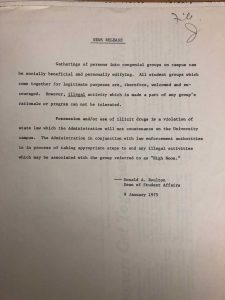Founded on April 11, 1904, the Order of the Golden Fleece is the oldest and highest honorary society at UNC. The presiding officer of the organization is called the Jason, and members of the order are called “argonauts.” Membership in the club was closed to women until 1972. Initiates to the society are classically inducted in public “tapping ceremonies,” an event where “giants” (the name for members of the Order disguised in black hoods) roam the audience of a campus event “tapping” those chosen for membership. After the ceremony, a guest speaker is called onto stage to give a lecture. Prior to the 1960s, the ceremony did not always include a lecture. In 1980, the guest lecture was named the Frank Porter Graham Lecture on Excellence. The following list is an incomplete timeline of speakers hosted by the Order of the Golden Fleece.
1930: Harry Woodburn Chase, UNC President
1942: Dr. Urban T. Holmes reads “Jason and the Argonauts”
1954: R. Mayne Albright
1955: Justice William H. Bobbitt
1958: Clifton L. Moore
1959: Lenoir Chambers
1960: Albert Coates
1961: Terry Sanford, NC Governor
1965: Frederick Henry Weaver
1966: Lennox Polk McLendon, Jr.
1967: Edward M. Yoder, Jr.
1968: Professor Walt Spearman
1969: Charles Kuralt
1970: Tom Wicker of the New York Times
1971: Richardson Preyer, NC Congressman
1972: William D. Snider, Editor
1973: James B. McMillan, Federal District Court Judge
1975: Howard Lee, Mayor of Chapel Hill
1976: Ed Yoder
1977: Hamilton Hobgood
1978: Samuel R Williamson
1979: McNeil Smith
1980: Charles Kuralt
1981: Richardson Preyer
1982: Hargrove Bowls, Jr.
1983: Jim Hunt, NC Governor
1984: James Cooper, U.S. Congress, Tennessee
1985: Dean Smith
1986: James Leutze
1987: Terry Sanford, U.S. Senate, N.C.
1988: Anson Dorrance
1989: Alexander Heard
1990: Judith A Hines
1991: Julius L Chambers
1992: Willis Padgett Whichard
1993: Richard Allen Vinroot
1994: Marie Watters Colton
1995: Chuck Stone, Jr.
1996: Shelby Foote
1997: Dr. Julius Chambers
1998: Edwin M Yoder, Jr.
1999: Erskine Bowles
2000: Benjamin S. Ruffin
2001: Richard J. Richardson
2002: Doris Betts
2003: Robert Kirkpatrick
2004: Dr. Francis Collins
2005: Phillip Clay, MIT Chancellor
2006: Woody Durham
2008: Ambassador Stuart Eizenstat
2009: Jonathan Reckford
2012: F. Taylor Branch
2014: Mia Hamm
2015: Carol Folt
2016: Thomas W Ross, Sr.
2017: Kevin Guskiewicz
2018: Bland Simpson
References:
Daily Tar Heel (articles cited above).
Order of the Golden Fleece of the University of North Carolina at Chapel Hill Records, 1904-2017
Finding Aid: http://finding-aids.lib.unc.edu/40160/
G. Nicholas Herman, The Order of the Golden Fleece at Chapel Hill, 1904-2004 (Chapel Hill: The University of North Carolina at Chapel Hill Library, 2005), 58.



